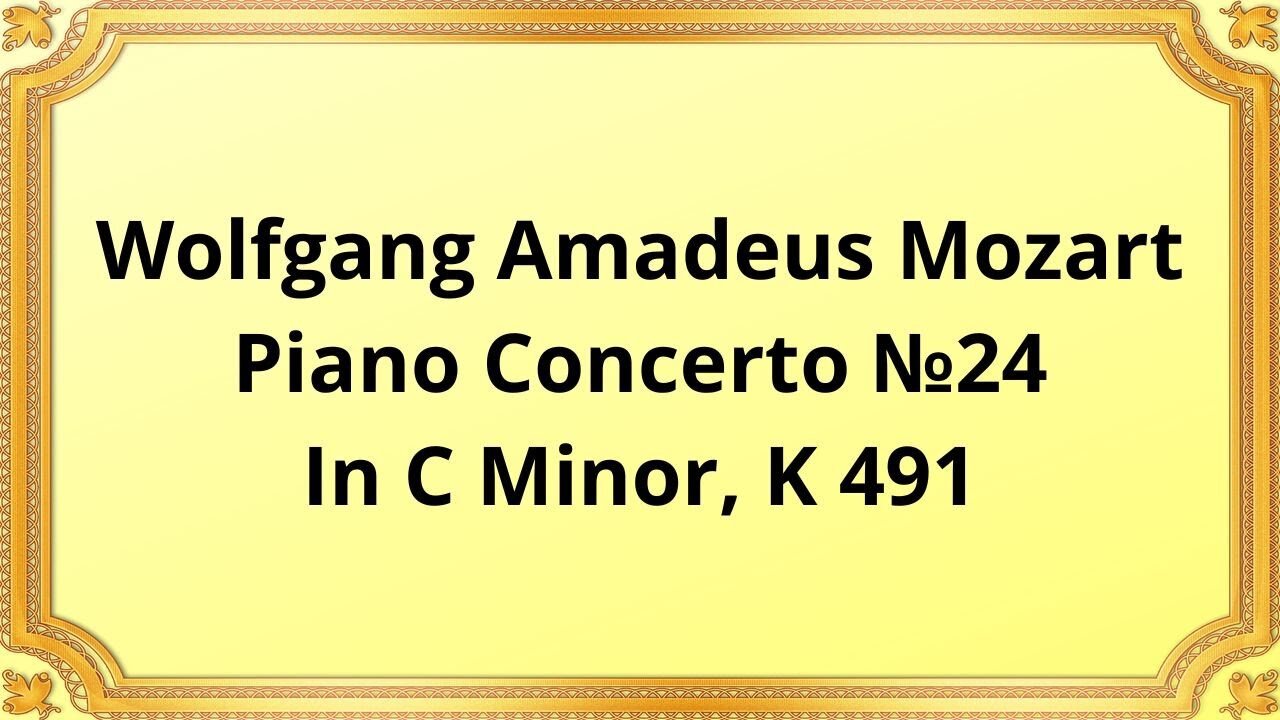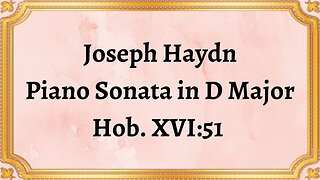Premium Only Content

Wolfgang Amadeus Mozart Piano Concerto №24 In C Minor, K 491
#Mozart #classicalmusic #pianoconcerto #musicalcomposition #Cminor #K491 #WolfgangAmadeusMozart
PRO MUSICA ORCHESTRA, VIENNA
Soloist Ingrid - Haebler
Conductor - Paul Walter
Wolfgang Amadeus Mozart, a musical genius of the Classical era, composed numerous exceptional works that have left an indelible mark on the world of classical music. Among his remarkable compositions, Piano Concerto No. 24 in C Minor, K 491, stands as a testament to his mastery and artistic brilliance.
Composed in 1786, Piano Concerto No. 24 in C Minor, K 491, belongs to Mozart's mature period. During this time, Mozart was at the height of his creative powers, pushing the boundaries of classical music and exploring new realms of emotional depth and complexity. This concerto reflects the shifting musical landscape of the late 18th century, marked by the emergence of the Romantic movement.
Mozart's Piano Concerto No. 24 follows the standard three-movement structure prevalent in classical concertos. The first movement, Allegro, introduces the main themes and establishes the tonal and emotional landscape. The second movement, Larghetto, provides a contrasting and introspective experience with its lyrical and melodic beauty. Finally, the concerto concludes with a spirited and virtuosic Rondo, showcasing the technical prowess of the soloist.
Mozart's choice of C minor for this concerto adds a sense of darkness and emotional intensity to the composition. The key's inherent melancholy and dramatic nature allow Mozart to explore a wide range of emotions, creating a captivating and evocative musical journey.
The solo piano part in this concerto is exceptionally demanding and showcases Mozart's deep understanding of the instrument. It combines technical virtuosity with expressive melodies, allowing the pianist to convey a wide range of emotions, from moments of tender introspection to passages of fiery passion.
The orchestration in Piano Concerto No. 24 is rich and varied, featuring a full-scale orchestra with strings, woodwinds, brass, and timpani. Mozart masterfully balances the interplay between the soloist and the orchestra, creating a dialogue that alternates between moments of collaboration and moments of contrast.
One of the defining characteristics of this concerto is its emotional depth. Mozart's exploration of contrasting emotions, from profound sadness to moments of triumph, captivates the listener and immerses them in a world of profound musical expression.
Piano Concerto No. 24 in C Minor, K 491, remains a testament to Mozart's unparalleled compositional skill and his ability to create music that transcends time. Its emotional depth, technical brilliance, and masterful orchestration have made it a beloved and frequently performed piece in the repertoire of pianists and orchestras worldwide. The influence of this concerto can be seen in the works of later composers, who were inspired by Mozart's innovation and expressive power.
Conclusion:
Wolfgang Amadeus Mozart's Piano Concerto No. 24 in C Minor, K 491, stands as a pinnacle of his compositional genius. Through its exploration of contrasting emotions, expressive piano writing, and masterful orchestration, this concerto showcases Mozart's ability to create music that resonates deeply with the listener. Its historical significance, structural integrity, and striking characteristics make it a timeless masterpiece that continues to captivate audiences and reaffirm Mozart's position as one of the greatest composers in classical music history.
You have the opportunity to support the channel:
https://destream.net/live/RadSiarAl/donate
https://www.buymeacoffee.com/6355radsiaral
-
 6:07
6:07
Classical music_Music Inspiration
11 days agoJoseph Haydn Piano Sonata in D Major, Hob. XVI:51
401 -
 LIVE
LIVE
The Quartering
49 minutes agoTrump Impeachment, Democrat Insurrection, Massive Scandal At Politico & DC Crash Update!
3,712 watching -
 1:06:29
1:06:29
Russell Brand
2 hours agoGaza Takeover? Trump’s Bold Plan Sparks Global Outrage – SF532
22.9K74 -
 LIVE
LIVE
Dr Disrespect
2 hours ago🔴LIVE - DR DISRESPECT - KINGDOM COME: DELIVERANCE 2 - FIRST IMPRESSION
3,922 watching -
 LIVE
LIVE
The Charlie Kirk Show
1 hour agoGaza Thoughts + DOGE The Destroyer | Sen. Schmitt, Benz | 2.5.2025
10,146 watching -
 LIVE
LIVE
Simply Bitcoin
2 hours agoNEW REPORT: Bitcoin ETF Insider Doubles Down on UNTHINKABLE 2030 prediction! | EP 1176
288 watching -
 LIVE
LIVE
The Dana Show with Dana Loesch
1 hour agoTRUMP PLANS TO TAKE OVER GAZA | The Dana Show LIVE On Rumble!
593 watching -
 59:36
59:36
The Dan Bongino Show
4 hours agoTrump Shocks The World With Major Announcement (Ep. 2416) - 02/05/2025
505K859 -
 1:19:04
1:19:04
The Rubin Report
2 hours agoTrump & Netanyahu Shock with Truly Unexpected Plan for Gaza
44.5K51 -
 1:59:23
1:59:23
Steven Crowder
4 hours ago🔴 Trump's Hitlist Grows: USAID, Dept. of Education, CIA, and... Gaza?
316K313